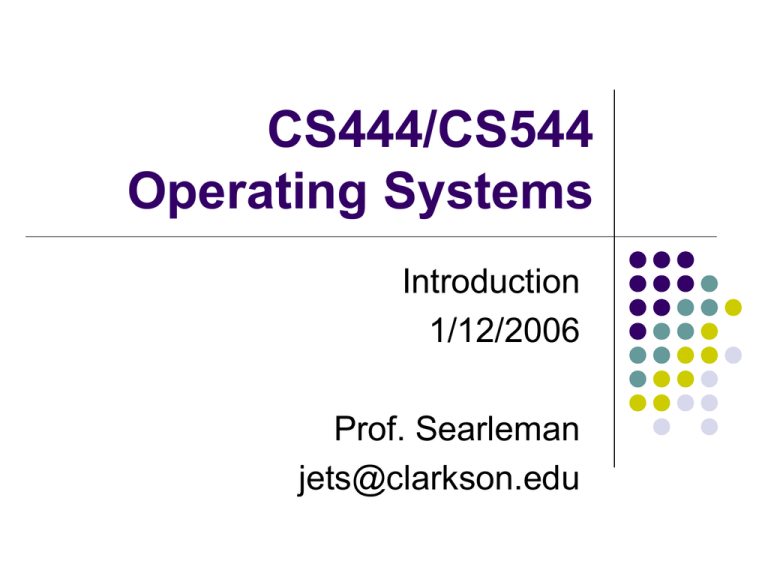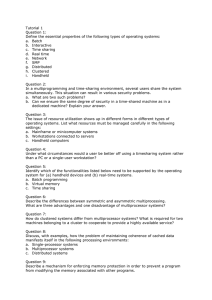PPT
advertisement

CS444/CS544 Operating Systems Introduction 1/12/2006 Prof. Searleman jets@clarkson.edu CS444/CS544 Spring 2006 Objectives of this course Administrivia Overview of Operating Systems Course Objectives To introduce students to the abstractions and facilities provided by modern operating systems. To familiarize students with the issues that arise when implementing operation system services Administrivia course webpage: http://www.clarkson.edu/~jets/cs444/sp06 contact info: SC375, x2377, jets@clarkson.edu, IM jetsza office hours: check webpage TA: Jason Herne Textbooks Required: Operating System Concepts, 7th Edition, by Silberschatz, Galvin, and Gagne, John Wiley & Sons, 2005, ISBN 0-471-69466-5. Recommended: The C Programming Language, ANSI C, Second Edition, by Kernighan & Ritchie, Prentice Hall, 1988, ISBN 0-13-110362-8. Grading Policy 30% 30% 10% 30% Midterm Exams Final Exam Homework & Quizzes Laboratory Projects What is an operating system? Applications A software layer that Operating Systems Hardware manages hardware resources “who gets what, when” provides an abstraction of the underlying hardware that is easier to program and use “virtual machine” Hardware Resources CPU, Functional Units, Registers Main memory access Storage devices (disk drives, CD-ROMs, tape drives) Network Interface Cards Human I/O devices (keyboards, monitors, mice) Other? Printers, cameras, sensors, … How much do you know about what it would be like to interact with these devices without an OS? The interface should be convenient, fair & efficient Objectives convenience efficiency ability to evolve an OS should be designed so that new services can be developed, tested, and deployed without (or minimally) disrupting current services Benefits of Operating Systems (1) Abstracting the Hardware Gory details of the raw hardware hidden so applications can be smaller and simpler Application writers can program to a simpler and more portable “virtual machine” Providing useful logical abstractions New types of logical resources (sockets, pipes) Benefits of Operating Systems (2) Protecting applications from each other Enforce “fair” allocation of hardware resources among applications Policies that say what is “fair” and mechanisms to enforce it Supporting communication and coordination among applications Support abstractions through which different applications can share data and notify each other of events What an operating system is not Compiler Standard libraries Command Shells These are closely related pieces of system software, but they are not the OS. Is OS code like other code? Most OSs implemented in C Developed without space-age development environments (kernel debuggers?) The buck stops here! OS must deal with gory hardware details Try to keep hardware dependent parts isolated What happens when get a device interrupt in the middle of executing an application? What happens when get a device interrupt while servicing another device interrupt? What happens if you take a page fault while executing operating system code Performance and reliability are crucial! Still a lot more like application code than you might think Lots of variety of OSes Unix (Solaris, HP-UX, AIX, FreeBSD, NetBSD,OpenBSD…); Linux Windows XP, 2000, NT, ME, 98, 95 BeOS MacOS, OS X OS 360, CMS, MVS, VM, z/OS PalmOS WindowsCE Mach, Amoeba, Sprite, Vino, SPIN, QnX, … What distinguishes operating systems? When people talk about which operating system to run, they often talk about: Look and feel of the desktop windowing system Devices that are supported What hardware platforms does it run on? Applications that are available for that OS Who developed the code? Who supports the code? How often does the system crash? Reliability? Do you pay for it? Are these really core OS issues? Core OS Issues: OS Structure How is the OS structured? One monolithic kernel of spaghetti code One monolithic kernel that is internally composed of distinct layers One monolithic kernel that is internally composed of distinct objects Micro-kernel with trusted user level applications that provide major OS functionality like virtual memory, scheduling, file systems, etc. Software engineering question Maintainability? Performance? Reliability? Portability? Core OS Issues Concurrency Protection How many and what types of activities can occur simultaneously? What is the granularity at which permission to access various resources are granted? How do you verify an entity’s right to access a resource? Fault Tolerance How do we deal with faults in applications? In devices? In our own OS code? Core OS Issues Resource/services provided to applications Naming How do applications refer to and request the resources they want for themselves? Resources they want to share with others? Sharing Does the OS offer kernel support for events? Signals? Threads? Pipes? Shared memory? What objects can be shared among applications? What is the granularity of sharing? Resource Allocation and Tracking What is the unit (or units) of resource allocation? Can we track ( and bill for) resource usage? Core OS Issues Service Time Guarantees What guarantees (if any) are made to applications about the servicing of their requests or about the servicing of device interrupts? Real-time OSs Scale/Load What are the limits of resource allocation? (Biggest file, Maximum number of processes, etc.) What happens as the demand for resources increases? (graceful degradation? ) Core OS Issues Extensibility /Tuning What interfaces are provided to change operating system behavior? How does (or does) the OS optimize its behavior based on the characteristics of the hardware or the application mix? Programmers/users demand performance Users want to realize the full “advertised” capability of a hardware resource Operating System usually provide the desired functionality at a cost of some overhead (tax like the government) If they have a disk capable of 20 MB/sec transfer rate, then they would like to be able to read files at that rate If they have a network interface card capable of 100 Mbit/sec transmission rate, then they would like to be able to send data at that rate Avoid seek and rotational delay when reading/writing to the disk Avoid control messages sent over the network Use a minimum of memory/disk space Programmers/users want that tax to be at a minimum Performance Optimization Operating systems try to optimize their algorithms to minimize the “tax” on applications What algorithms minimize the tax? That is a hard question – depends on what your workload is Example: What data do you keep in memory? LRU is generally good but is exactly the wrong thing for large sequential accesses Optimize for the “common” case? Adapt? Let applications give hints? OS Goals So operating systems should: Abstract the raw hardware Protect apps from each other Not allow applications to monopolize more that their fair share of system resources Provide desired functionality Expose the raw capability of the hardware, minimizing the “tax” Optimize for the expected (any?) workload Be simple enough that the code executes quickly and can be debugged easily Does this sound like a big job to anyone? Topics OS History, Architectural Support Processes, Threads Scheduling Synchronization, Deadlock Memory Management File Systems, IO Devices Networks, Distributed Systems Security Evolution of Operating Systems At first, OS = library of shared code Every programmer did not write code to manage each device Each application when compiled contained the “OS” Load into memory and execute By who? People = Operators How? By mechanical switches at first, then punch cards Just one application at a time so no need for protection and no need for sharing No virtual memory; either the entire program fit into memory or programmers handled moving sections of their own code in and out of memory Batch Processing Still only one application at a time Operating system rather than operators loaded one job after another off of punch cards or tape OS knew how to read next job in, execute it and when it is done take control back to read next job Operating system stayed in memory permanently Spooling Problem Card readers are slow Time to read the next job from punch cards means lost CPU time (expensive!) Solution: while executing one job, load the next one into memory Might even bring multiple jobs into memory and allow them to be executed out of order Need scheduling algorithm to choose the next one to run Multiprogrammed Batch Systems Keep multiple job in memory at the same time and interleave their execution (rather than pick one and run it to completion) The applications still couldn’t communicate directly (no pipes, sockets, shared memory, etc.) So why allow more than one to run at a time? Able to overlap I/O of one application with the computation of another! If one job requests I/O, don’t leave the CPU idle while I/O completes- pick something else to run in the meantime Each job take longer to actually run on the machine, but better machine utilization and throughput (important for expensive CPUs) Batch vs Multiprogrammed Batch Multiprogramming Requires much of the core OS functionality we will study CPU scheduling algorithm to decide which one of the runnable jobs to run next Memory management (simple at first) Protection of I/O devices from multiple applications desiring to use them Asynchronous I/O CPU issues a command to a device then can go do something else until job is done Device notifies CPU of completion with an interrupts or CPU periodically polls device for completion This Semester Architectural support for OS; Application demand on OS Major components of an OS Scheduling, Memory Management, Synchronization, File Systems, Networking,.. How is the OS structured internally and what interfaces does it provide for using its services and tuning its behavior? What are the major abstractions modern OSes provide to applications and how are they supported? Reading Assignment: By 1/17/06, read: - Chapter 1 (Introduction) - Chapter 2 (OS Structures) By 1/19/06, read: - Chapter 3, sections 3.1, 3.2 & 3.3











